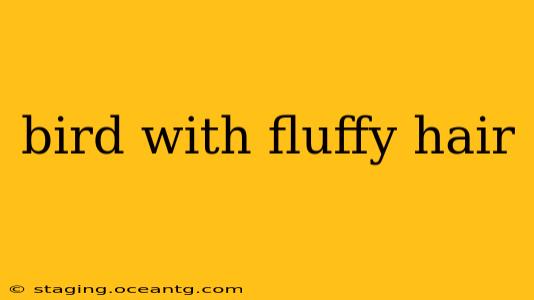The phrase "bird with fluffy hair" conjures up images of charming, almost cartoonish creatures. While no bird actually has hair, many species boast striking crests or plumes that resemble fluffy hair, giving them a uniquely endearing appearance. This captivating feature is more than just aesthetics; it plays a vital role in their communication, courtship, and even thermoregulation. Let's delve into the fascinating world of birds with these impressive head adornments.
What Birds Have Fluffy Hair-Like Crests?
Several bird families feature species with crests that might be described as "fluffy hair." Some of the most notable examples include:
-
Crested Cockatoos: These magnificent parrots are arguably the most iconic examples. Their large, erectile crests can be raised and lowered, adding to their expressive nature. The Goffin's cockatoo, Sulphur-crested cockatoo, and Umbrella cockatoo are just a few examples of species with impressively fluffy crests.
-
Various Species of Grebes: Certain grebe species display crests during mating season, showcasing elaborate plumes that contribute to their stunning courtship displays. These crests can appear fluffy and feathery, adding to their overall elegance.
-
Kingfishers: While not all kingfishers boast "fluffy hair," some species have crests that appear somewhat dishevelled or fluffy, particularly when ruffled.
-
Some Owls: Several owl species possess prominent ear tufts that, while not technically fluffy hair, give a similar visual impression. These tufts often contribute to the owl's overall mystique.
What is the Purpose of a Bird's Fluffy Crest?
The purpose of a bird's fluffy crest isn't always the same across species. However, several common functions exist:
-
Communication and Courtship: Crests are often used in communication, especially during courtship displays. By raising or lowering their crests, birds can signal their mood, intentions, and availability to potential mates. The size and prominence of the crest can also be a significant factor in attracting a mate.
-
Thermoregulation: In some species, the crest might aid in thermoregulation. By exposing or concealing the crest, birds can control their body temperature. This is particularly relevant in hot or cold climates.
-
Camouflage and Defense: While less common, in some cases, the crest can offer a degree of camouflage or help deter predators. A sudden display of a large crest can startle a potential attacker.
Why Do Some Birds Have Fluffy Crests and Others Don't?
The presence or absence of a fluffy crest is a result of evolutionary pressures and adaptations to their specific environment and lifestyle. Birds that live in social groups and engage in elaborate courtship rituals are more likely to have prominent crests used for communication and display. Birds in environments where camouflage is crucial are less likely to have such striking features. The genetic makeup of each bird species also plays a crucial role in determining the presence and characteristics of a crest.
How Does the Bird Control Its Fluffy Crest?
The control mechanisms vary depending on the species. Most often, muscles at the base of the crest allow the bird to raise and lower it. The feathers themselves may also play a role in the overall appearance of fluffiness, with the barbules (smaller feather branches) contributing to a softer, fuller look.
Are There Birds with Fluffy Hair-Like Crests That Are Endangered?
Unfortunately, yes. Several species of crested birds, including certain cockatoos and grebes, face threats such as habitat loss, poaching, and the illegal pet trade. Conservation efforts are crucial to protect these beautiful creatures and their unique characteristics.
This exploration into the world of birds with "fluffy hair" reveals the captivating diversity of the avian world. From the majestic cockatoo to the subtly crested grebe, these birds showcase the incredible adaptations that have allowed them to thrive in diverse ecosystems. Further research into specific species will reveal even more fascinating details about these striking head adornments and their remarkable functions.
